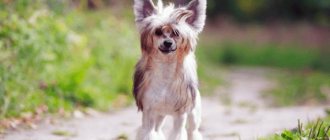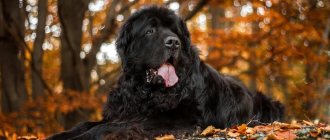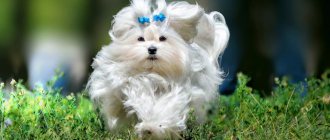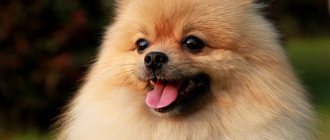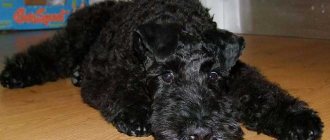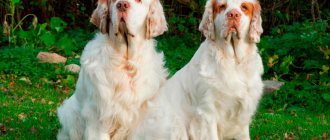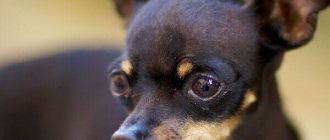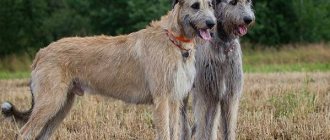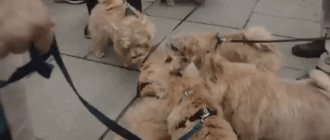The Chinese Crested is a type of dog with a good-natured and easy-going character.
There are a couple of varieties of the breed: hairless and powdery Chinese Crested (powder puff). Baldness of the skin occurs due to natural mutation processes in genes. The baldness gene gradually became dominant. But in contrast to it, a recessive gene responsible for hair follicles also works. It is for this reason that puppies can be born in one litter, both naked and with fur. Puffballs are tiny dogs with long, thick fur that require regular attention and care.
The animal will compensate for the attention and careful care with its own devotion, energy and friendliness.
Description and features
Based on the name of the breed, it is easy to conclude that it is popular primarily in China. In this country, the dog is treated like a mascot. It is believed that if you bring a small crested cat into your home, prosperity and prosperity will appear there.
These animals are also popular in most European countries. The main feature of the Chinese Crested dog is its unusual appearance. Her skin is almost bare, and on her head there is a mane of smooth and pleasant to the touch wool.
This breed is very ancient, and the history of its discovery is full of secrets and mysteries. According to a popular version, in ancient times an African breeder came to China to breed hairless dogs.
Presumably, this breed appeared around 1000 BC. e. In ancient times, its representatives were treated with great respect. They were pampered, loved and even idolized.
The Chinese crested dog had a special “home” purpose - to warm the owner during sleep. Despite the almost complete absence of fur, the skin of such a dog emits a large amount of heat.
Residents of the ancient world believed that the owners of such pets got sick less and lived longer. Crested dogs were credited with medicinal properties, and people also believed that these dogs had psychedelic effects, that is, they could influence people’s mood.
Interesting ! Modern Indians insist that Chinese crested dogs have miraculous properties. In their opinion, these animals are able to relieve human toothache, relieve insomnia and cure rheumatism.
Thanks to Asian sailors, the world learned about representatives of this breed in the 16th century. They were standardized only in the second half of the 20th century. Despite the fact that these wonderful animals were brought from Asia, England is considered their homeland. Why? It was in this country that clubs for Chinese Crested lovers first appeared and began actively breeding dogs there.
Despite its cuteness and diminutive size, inside such an animal there is a lion dormant. It is proud, strong and very resilient. Many people underestimate the power of decorative dogs, but in vain. The Crested is one of the best companion dogs. She quickly and for a long time becomes attached to one person, preferring to be near him all the time. But sometimes she likes loneliness.
Health
Characteristic diseases
— Allergies — Perthes disease — Patella luxation — Keratoconjunctivitis — Dental problems. Often teeth fall out at an early age.
The Chinese Crested Powder easily fits into the family and becomes a real pet.
Vaccinations
The first vaccination is given at 8-10 weeks against leptospirosis, parvovirus, parainfluenza and infectious hepatitis, revaccination after 3-4 weeks; The 2nd vaccination is given at 12-13 weeks against rabies; the 3rd at 6 months against trichophytosis and microsporia at 12 months - general revaccination
general vaccination is carried out once every year .
Before any vaccinations, you need to make sure that the dog is healthy and dewormed.
In general, your dog should be given anthelmintic drugs 2-3 times annually.
If you don't know how to give your dog a pill, we recommend reading this article:
When caring for the coat of a Chinese Crested, special attention should be paid to trimming the face.
Breed standard
Decorative dogs are notable for their small size and weight. The Chinese Crested breed is characterized by the absence of hair on almost all parts of the body. The maximum permissible weight for its representatives is 5 kg. Some miniature bitches weigh no more than 2.5 kg. Height at withers – from 27 to 32 cm.
The animal's build is stocky. His torso is stretched forward, his stomach is strongly tucked. Hairless representatives of the breed have clearly visible ribs on their bellies. The sternum is wide, slightly protruding. The dog's paws are thin, graceful, elongated. The front ones are shorter. The tail is long and cannot be docked. Is mainly in a supine position.
A stop is clearly visible on the crested head - the transition of the forehead to the muzzle. The frontal line is wide, and the oral line is elongated. The dog has an excellent bite. The mouth has white sharp teeth. By the way, they often fall out for anatomical reasons. A dog with missing front teeth is not eligible to participate in any competition and will be disqualified.
The Chinese Crested in the photo looks inquisitive and interested. This is due to the unusual shape and structure of her eyes. They are large, almond-shaped, and protrude slightly.
The iris is most often black or brown, but in representatives of the breed with light skin it can be sandy or cream. Less commonly, such dogs are born blue-eyed. According to the standard, the iris of each eye should be monochromatic.
The ears of crested cats are large and erect. They have delicate fur. Hair is also present on the tips of the dog's legs, tail and back of the neck. Exhibition representatives of the breed are regularly clipped. Sometimes their fur is smoothed with an iron.
Features of caring for your puff
For a knowledgeable owner, powder poufs are not as difficult to care for as they might seem. But inexperienced owners must receive at least minimal theoretical training, as well as practical skills, in order to keep their pets’ coat healthy and beautiful.
What tools will you need?
If you plan to learn how to maintain the perfect appearance of your puff yourself, you will need a whole grooming arsenal. Of course, you can refuse some positions, but you need to take care of your beauty’s hair every day, and it’s better to have the right tools on hand - not to run to the dog hairdresser every day. So, what exactly is useful in care:
- a massage brush is an essential item. It is indispensable for daily combing, drying hair after washing and final grooming before entering the ring; a mitten brush is also convenient;
- good scissors - simple and thinning - are valuable assistants in trimming the tips of the hair on the paws, tail, ears and in thinning the fur where necessary;
- A hairdryer will not only make it easier to dry your pet after washing, but will also help in straightening and styling the fur;
- a clipper is necessary for trimming fur on the face, neck, paws, ears, and in the area under the tail;
- a trimmer is an alternative to a clipper for detailed haircuts, for example, on the ears or in certain areas of the face;
- a slicker is needed to remove dead hair and give the coat the desired volume and shape;
- a comb with a knitting needle will be needed to detect random tangles and form the correct parting;
- a hair straightener (iron) is necessary when preparing for exhibitions - with its help the fur coat becomes perfectly straight;
- A brush with natural bristles is intended for the final stage of grooming immediately before entering the ring; it will also help remove cut hairs after cutting with a clipper.
The “Drop” tangle cutter is convenient for untangling tangles
But it is better not to use single-row metal combs for this breed - they stretch and even tear the fur, leaving severely split ends
Combing, haircut
An important rule that both breeders and good groomers are well aware of: combing tufted puffballs must be done extremely carefully, without sudden movements and only according to the growth of the fur - in no case vice versa. Many connoisseurs of the breed prefer not to use any tangle cutters, but rather untangle the matted fur with their fingers.
If the puff is not shaved or epilated, then the haircut itself includes four main stages:
- shaving the muzzle and V-shaped shirtfront;
- paw outline;
- removing hair from the area under the tail;
- general refreshment of the coat and giving it a breed shape.
Short hair is a great everyday option
There are two acceptable options for decorating the ears: either shaving with a machine or trimming along the contour with scissors. Both look very nice, but a long haircut is only suitable for those dogs whose ears have been well set since childhood.
Human clippers are not suitable in this case at all - they do not take the silky hair of the tufted puff. Of the variety of machines, it makes sense to choose only the best - from Moser (Germany) or Oster (USA), which serve reliably and give excellent results when grooming. Different knives can be used, depending on the quality of the wool and the task at hand - from one to three millimeters.
Video: grooming a Chinese crested puffball
Bathing
The usual recommendation for many other dog breeds: the less often we bathe, the better - in our case it does not work. The Chinese puff needs to be washed frequently - about once a week. Therefore, stock up on special equipment - cosmetics for your pet:
- shampoos;
- balms;
- air conditioners;
- light oil for long-haired dogs;
- products for untangling tangles and for styling.
You will need a lot of all this - beauty requires money. And saving money by buying dubious products at a cheaper price is very risky - you can irrevocably ruin the luxurious fur, and then you will have to shave the hairless crested one from the downy one. Owners of show dogs bathe them even more often - every four to five days. That’s why it’s so important to choose a gentle detergent—you can try, for example, something from this list:
- 8in1 Tea Tree oil Shampoo;
- Espree Bright White Shampoo;
- Artero Blanc;
- Herba Vitae;
- RolfClub (R416);
- Clini.
Frequent washing is inevitable if you want to grow your beauty a long hairstyle - dirty, unkempt fur will quickly break and will not grow properly. A little secret from professional groomers: the coat should be perfectly combed before each bath. And you need to comb it not in a dry, but in a slightly moistened state - both special “unraveling” sprays and ordinary water are suitable for this, but it must be soft and filtered.
Proper washing of wool is the key to its good condition
How to properly bathe a puff? To do this, you need to follow a certain sequence of actions:
- Dilute shampoo or shampoo concentrate according to the instructions in warm water (usually the ratio of detergent to water is 1:4) and beat the solution into a strong foam.
- Place the animal in the bathtub, at the bottom of which it is advisable to place a silicone mat or just a terry towel so that your baby’s paws do not slip.
- Thoroughly wet the fur with warm water from the shower along its entire length, from the skin to the tips - this is an important step, treat it responsibly.
- Apply pre-prepared washing foam to the wet coat using a sponge or just with your hands - you need to start soaping from the tail and hind legs, gradually moving towards the head, washing the head last.
- Lightly massage the soaped skin and very carefully distribute the shampoo over the coat, never stretching it.
- Rinse off the foam with plenty of running water, working in reverse order, from the head to the hind legs.
- It is better to do the last rinse with cool (but not very cold!) water - this helps close the cuticles of the hairs.
- Using your palms, lightly squeeze out excess water and immediately apply a nourishing balm to the coat - this will improve the quality of the top coat hair and reduce tangling.
- Leave the balm on the fur for the time specified according to the instructions (most often it is about two minutes) and rinse very thoroughly with a shower.
- Dry the coat a little (not completely), and then spray it with styling product, if necessary, then carefully comb the dog.
You should massage your dog’s skin not only when lathering, but also during the period of action of the balm - this way you will not only enhance its effect, but also caress your pet and prevent it from getting hypothermic.
Video: bathing the puff correctly
How to dry wool correctly
After bathing and gently squeezing out the fur, the baby is wrapped well - a soft terry towel of sufficient size or a special diaper for bathing dogs will do.
A powerful compressor is usually not used for dogs of this breed - it, of course, greatly speeds up the drying process, but is too large and strong for a baby powder poof. It is better to dry it with a regular hairdryer, but not in hot mode. Although the most gentle option is, of course, natural drying in the open air.
Chinese Cresteds, unfortunately, are often sickly; they must certainly be protected from hypothermia and drafts, especially during the cold season. Make sure that the room in which the dog is located after bathing is warm and not drafty.
Kinds
The most common is hairless, that is, hairless Chinese Crested. But there is another type of breed - downy. Let's look at each of them.
- Naked. The fur of the animal on the top of the head folds into a small tuft - hence its name. The hair on the tail is straight and forms a “tassel”. At the tips of the paws, it should also not be wavy, it resembles boots. This individual has no undercoat. The dog's skin is very delicate and almost always warm. Show-class dogs should have thick head fur so that they resemble small lions.
- Downy. The main difference between this type of breed is the presence of thick fur throughout the body. There are few such dogs. The fur on the body and tail is stiffer. Downy crested cats have an undercoat. It needs to be looked after regularly.
As for the requirements for the color of the skin and fur of such a dog, there are none. It may have small gray spots on its pinkish-white body. This is acceptable according to the standard. The downy representatives of the breed often have black, white and gray-beige hairs. Less commonly, they are born with brown markings.
How to choose a puppy
The coat color of down fur coats can change with age.
Consideration of the pedigree of the dogs, the colors of their parents and other ancestors can bring some clarity to this issue.
By the age of three months, you can also see from the roots of the hair what color the dog will be.
This breed has absolutely no aggression, so don't worry if your Chinese Crested puppies are hyperactive. This is normal and correct. And their appearance should be like this:
- relatively strong bones;
- straight back;
- expressive angles of the limbs;
- scissor bite;
- pink, clean and smooth tummy;
- clean, without cloudy discharge, eyes, nose and ears.
The Chinese Crested Powder loves to race with its relatives.
Character
The small hairless dog, originally from ancient China, is the ideal home companion. He quickly becomes attached to a person who is affectionate with him. He does not tolerate aggression towards himself. Sensitive to the mood of each household member. He is devoted to them, prefers to always be nearby.
Living with such a pet is a great pleasure. He will never demand from a person what he cannot give him. Affectionate, gentle and very loving. He treats people from his family with reverence.
Such a dog is completely devoid of malice. She is completely ineffective as a security guard and bodyguard. Even if an armed robber comes to your house, she will warmly welcome him.
This cute animal was created exclusively for love and tenderness, but not for aggression and suspicion. True, there are situations that can greatly agitate him, for example, family quarrels, screaming.
Being in an unfavorable psychological environment, the dog will find a secluded place and wait out the “storm” there. Usually he stays close to his owner, but if he is in a state of anger or strong malice, he will leave him and retire.
They say that the Chinese Crested is a mood dog. She spends most of the day next to her loved ones, accompanying them everywhere. Well, as soon as something affects her mood, she will leave them to be alone. Sharp mood swings are typical for representatives of this breed.
The second special character trait of such a dog is curiosity. In a home or outdoor setting, he feels like an explorer of the world. He likes to sniff out the ground, living things, including dogs, objects on the floor, etc.
Good nature and a gentle attitude towards living beings helps the crested cat to socialize without problems in an apartment in which pets already live. Rest assured, even without your intervention she will get along with everyone!
When guests arrive, they may show shyness. When a person who comes to the house speaks affectionately to a cute hairless dog, it will melt her heart, and she will definitely come up to receive a portion of attention from him.
But the dog avoids unfriendly and rude strangers. She frankly doesn't like them. A pampered animal requires affectionate treatment, care and attention. Without this, he becomes very nervous, sad and can behave apathetically.
The Chinese Crested has one more feature - excellent mental abilities. The breed is incredibly savvy. Such a dog always understands if his owner is upset about something. He is trying to be close to him at this moment. And if the owner is joyful, then the dog is also present near him to share this emotion.
Interesting Facts
At the same time, cases of the birth of hairless and downy puppies are recorded in the litter. Pets love fruit. If the choice is between an apple, meat and sausage, they will choose the first.
Based on the research, it became obvious that many owners of this breed are creative individuals. They are often kept by musicians and artists. Chinese Cresteds are endowed with healing properties.
Advantages:
- — easily learn to go to the toilet and litter tray.
- - they adore children and will never bite them.
- — there is no molting process.
- - does not require a large living space.
- — distinguished by such feelings as loyalty, friendliness and non-conflict, free learning of training exercises.
- - ease of care and maintenance.
- - free proximity to any animals, not cocky.
- — intuitively guess the owner’s mood.
- - compact, odorless, clean and tidy, quiet - she won’t bark or howl too much.
Care and maintenance
Caring for a hairless representative of the breed is more difficult than caring for a downy one. Delicate skin requires care and regular cleaning. This pet bathes every week! It is important to choose the right shampoo for him.
It is desirable that it does not contain aggressive chemical elements. We recommend buying a simple tar shampoo for your Chinese Crested (preferably for decorative dogs with delicate skin).
For exhibition animals, the use of moisturizing conditioners is also recommended. An additional care product is nourishing body milk. It contains vitamins and nutrients for the epidermis.
Such a dog must have his own towel. It is advisable to use soft, terry cloth. Dry her body after every bath. But you cannot use alcohol wipes to wipe the body of such a dog. This will cause him to develop severe skin itching.
What else does the owner of a Chinese Crested need?
- Pukhoderka. It is advisable to use such a tool not only for downy dogs, but also for hairless representatives of the breed.
- Massage brush with natural bristles.
- Metal pet comb (only for long-haired animals).
- Toothbrush with hard bristles. Every day, it should be used to remove plaque that forms in the dog’s mouth, regardless of food intake.
The owner of a Chinese Crested can trim it himself. To do this you will need an epilator or a specialized hair cutting machine. As for organizing a comfortable life for a dog, it needs a small and comfortable corner. You'll have to buy a soft lounger. It is easy to train a puppy to sleep on it. You can lay a sheet next to him, saturated with the smell of his mother.
You should not place your dog's bed next to a radiator or window facing the sunny side of the street. So he can overheat and get sick. Most owners of this breed allow it to sleep nearby, that is, on the sofa or bed. This is not a problem.
Contents of the Chinese Crested
A dog should be adopted by owners who are able to devote a lot of time to it.
The Chinese Crested needs a balanced diet to stay beautiful and healthy.
Nutrition
Newborn dogs need to be fed about 6 times a day, subsequently the number of meals is reduced to 2.
Chinese Cresteds are not demanding, but it is important to remember that they have a tendency to gain excess body weight.
Your daily diet should include:
- lean meat;
- fish; vegetables and fruits;
- chicken or quail eggs;
- porridge;
- cottage cheese;
- sunflower or olive oil.
It is forbidden to feed the Chinese Crested cat fried food, sweets, smoked meats, or baked goods. When feeding ready-made store-bought food, you should purchase premium and super-premium products.
It is better to give older dogs canned dog food to reduce the likelihood of tooth damage.
Care
The dog needs constant hygienic care, despite the lack of fur.
The Chinese Crested is not adapted to life outdoors; it needs clothing to protect it from dampness, frost and sunlight. At home, it is important for your dog to choose a comfortable sleeping place without drafts.
General care rules:
- regular combing of the coat with a soft-bristled brush and wiping bare skin with a napkin;
- washing with specialized shampoo once every 2 weeks;
- periodic treatment of the skin with herbal cream;
- washing limbs after walking;
- Grooming your Chinese Crested Dog as needed.
The dog should be bathed. Such dogs are afraid of very hot and cold water. After washing, the wool should be blotted with a towel and dried with a hairdryer. Only those dogs that do not participate in exhibitions can be groomed.
How to trim a Chinese Crested dog? It is best to trust a professional groomer who will turn your dog into a real handsome dog in a matter of hours.
Self-cutting is also possible if you only need to trim overgrown and protruding hairs.
Ears and eyes should be regularly wiped with cotton pads soaked in an antiseptic solution. Nails should be trimmed monthly (or more often if necessary).
A lot of attention is paid to the teeth - brushing with a special paste, showing the pet to the veterinarian.
Walks
Chinese Cresteds do not require regular outdoor visits as they are easily litter trained.
But it is better to walk your dog several times a day. This way the animals will actively socialize and get used to new people and places.
Outdoor physical activity prevents obesity. The dog gets tired and behaves more calmly at home.
Nutrition
Your Chinese Crested puppy must drink pasteurized milk every day. At 5-6 months they stop feeding him this product. During this period, his body will be enriched with calcium, his skeleton will become stronger and his immunity will improve.
After the baby matures, he is gradually transferred to dry food. You can add a little canned food or any food for dogs to boiled cereals. But it must be of high quality! Be sure to pay attention to the composition of such products.
Advice ! We recommend choosing a bowl with a tripod for your pet. It is easy to raise and lower. Adjust the height based on your dog's height. The bowl should be slightly below his muzzle for comfortable feeding. Breeders insist on providing the dog with a balanced diet. She should be given:
- Fresh fruits and vegetables.
- Bone cartilage.
- Boiled porridge.
- Soups and borscht.
- Cottage cheese.
Eating crested baked goods and sweets is unacceptable. You cannot overfeed such a dog!
Distinctive features
The Small Chinese Crested Dog can be easily identified by the following characteristic features::
- The head is small, elegantly shaped, smooth, with no furrow.
- The skull is rounded and elongated.
- The ears are strong, erect (for the Powderpuff species they are drooping), low set, and not cropped.
- The stop is not expressed.
- The muzzle is short, slightly narrowed, flat.
- The cheeks are narrow.
- Eyes with a wide set, medium; very dark, almost black, shiny. The whites are not visible.
- The nose is narrow and can be of any color.
- The lips are tight.
- The teeth are strong, strong, and can be of different lengths.
- The jaws are strong.
- bite .
- The neck is slightly arched, dry, smooth, elegant.
- The body is proportional and elegant.
- Skin without wrinkles, bare (for the bald type), even, clean, smooth, spotty.
- The back is straight.
- The hips are rounded, with pronounced muscles.
- The chest is rounded.
- Shoulders are narrow.
- The limbs are elongated, straight, perpendicular to the body.
- The paws are narrow, long, “hare-like”, and the stance is straight.
- The claws are long.
- Movements are smooth and energetic.
- The tail is thin, long, and in its natural state hangs down; during movement, slightly curved towards the body.
- color , in different combinations, the presence of vague dark spots of a round shape.
Chinese Crested dogs come in two varieties. Depending on the presence and thickness of the coat, they are divided into hairless and powderpuffs:
- Bald Chinese Cresteds have no fur on their bodies and their skin appears bare. But if you look closely, the dog’s body is covered with thin, soft fluff, which can have varying degrees of density - from extremely low to clearly visible. None of these options are a departure from the standard. The fur is usually located on the hind legs and slightly on the shoulder blades. However, hair may also be present in small tufts along the spine and on the hips. In any case, the coat consists of sparse, usually coarse hairs that must be removed regularly every 1.5-2 months. The chest, sides of the body and belly are smooth, hair is completely absent.
- Powderpuffs have soft, long hair all over their body and also have an undercoat.
No matter what variety the Chinese Crested belongs to, what distinguishes this breed is the presence of hair on other parts of the body . These are characteristic small tufts of hair on the head (bangs, tuft, any length, lush, thick or sparse are allowed, falling in a curl) and tail (characteristic plume).
The Chinese Crested can be conditionally divided according to another characteristic - constitution. Depending on the structure of the croup, they are called “deer type” and “pony” (another common name is “conics”):
- Deer type . Dogs of this variety have a thinner bone structure and look more elegant than their relatives.
- Ponies are strong, stocky representatives of the breed. They are distinguished by an emotionally calm, confident, balanced character. There are short hairs on the body, while the neck, head and paws are covered with thick hair.
Regardless of the classification of the adult, Chinese Crested puppies can be born either completely naked or with fur on the rump. In this case, “naked” and “powderpuffs” can appear in the same litter.
Reproduction and lifespan
Let us immediately note that only representatives of one breed species should be knitted. If you are allergic to dog hair, then your choice should be the Hairless Chinese Crested. Since these are peaceful and not at all aggressive creatures, they quickly become attached to each other, so there are usually no difficulties in their mating.
Both parents should have a lush crest of delicate wool on the top of their heads. This is the main sign of a purebred individual. They mate a male and a female on the 3rd day of her heat, because the probability of conception is so high.
A pregnant female dog becomes more tender. During 2-2.5 months of bearing offspring, she requires a lot of attention and care from household members. You cannot force a pregnant bitch to walk a lot, this will tire her. The average life expectancy of such dogs is 15 years. Some of them live up to 16-17 years, of course, with good care.
Price
There are not many good kennels in Russia where these dogs are bred. But, there are 2 for sure. One is in Moscow, and the second is in St. Petersburg. The cost of an animal depends on its breed.
Hairless individuals are 2 times more expensive than long-haired ones. The price of a Chinese crested cat (hairless) with documents and pedigree is 30-50 thousand rubles. Puffs are sold for 15-25 thousand rubles.
Breeders working outside of kennels sell such dogs cheaper, from 10 thousand rubles. It is important to distinguish a purebred representative of the breed from a mongrel. Remember, the first one has a delicate tuft on the top of its head.
Origin story
Cynologists do not have a single version of the origin of the animal. Scientists believe that the breed originated from Mexican hairless dogs, which are about four thousand years old. In some historical works dating back to the 16th century, there are fragmentary references to crested dogs.
The animals were often taken on voyages by Chinese traders. The dogs hunted rats and other small rodents that could spoil the goods. Sailors from Africa, India, Turkey and Malaysia also had four-legged travelers.
The popularity of the breed grew especially strongly in the 18th and 19th centuries. The crested dog was depicted in paintings by famous masters: Jacques-Laurent Agas and Adrian van Utrecht. Dogs often became the heroes of articles and books.
In the mid-20th century, the breed received official recognition from the Fédération Cynologique Internationale (FCI) and the American Kennel Club (AKC). In Russia, crested downy dogs are very popular among breeders. Breeding animals from the Russian Federation constantly become winners of international exhibitions.
Education and training
Don't rush to introduce your young pet to the outside world before he has been vaccinated. After the last vaccine, at least 2 weeks should pass, or better yet a month, before he goes outside. Why is it important? During this period, his body will develop antibodies to viruses and pathogens with which he will come into contact on the street.
Even if you have taught your Chinese Crested to go to the toilet in the litter box that is in the apartment, you will still have to take him outside. This is done for socialization. The animal must normally “enter” its society, it must learn to interact with other dogs.
To do this, he will need your help. When getting to know the outside world, it is important for the dog to understand that he is surrounded by your care. While walking, do not let anyone offend him. The pet should be picked up if dogs bark at it. This way he will understand that the owner is his protector and support. This is a very important awareness for the socialization of a decorative dog.
It is a mistake to think that a small four-legged pet cannot become a source of big problems. Chinese Cresteds have very strong teeth, with which they can bite people hard, while playing, of course. If the dog begins to bite you in a playful impulse, do not ignore it. You can shout at him or lightly slap him on the body. But don’t even think about hitting the animal!
These are playful and very funny dogs. They easily learn simple and complex commands, but they prefer fun games in the fresh air to boring training. The Chinese Crested loves to bring a plate to its owner, which he throws far ahead. She also likes to swim, run with children, lie in tall grass, etc.
Important ! To prevent your dog from getting sunburn, lubricate its skin with a cream with ultraviolet protection. There is no specialized training program for indoor dogs.
These are pampered and reverently related to all living creatures, who are bred, as they say, for the soul. But this does not mean that you can ignore the issue of raising a decorative dog. The Crested needs to be taught:
- Come when called.
- Don't shit in the house.
- Don't bite.
- Behave unobtrusively with guests.
- Always obey the owner.
Such an animal is suitable not only for young people, but also for older people who want to surround themselves with the attention of a cute four-legged pet. We recommend walking with him away from transport, as his natural curiosity can play a cruel joke.
It is difficult for drivers to notice the small gray-skinned dog that blends into the highway. Many Chinese Cresteds fall under the wheels of cars due to their excessive curiosity.
Such an animal must have a long leash. You can unfasten it only in nature or in a quiet secluded place, away from roads. The dog must know its name and always respond to it.
To teach her this, lure her with a treat and say the name out loud. This way the animal will develop the attitude that I will receive a treat for going to the owner when he calls me.
The Chinese Crested is a gentle, friendly and sensitive creature that needs love and care. You need to teach her anything consistently and patiently. You should never raise your voice at her, try to humiliate her or hit her. The animal will not forgive anyone, even its beloved owner, for physical or mental insult.
Possible diseases and methods of treating them
Periodically, the dog undergoes the process of changing teeth. It is advisable to see her at a veterinarian at this stage. This usually occurs at 4-5 months. Some of the crested teeth sit deep in the gums and are difficult to fall out.
But the renewed body quickly pushes out the old one, causing the dog to experience severe pain. Only a specialist can help him. He will remove old teeth and tell you what liquid should be used to wash the wounds formed in the dog’s mouth. The skin of a hairless Chinese crested cat is its vulnerable spot. In winter it should be insulated, and in summer it should be lubricated with cream with ultraviolet protection.
The oral cavity of such a dog is often affected by pathogens. The fact that an animal has diseased teeth or gums is evidenced by its constant whining. Also, a sick dog refuses food, because he knows that chewing will increase pain.
The best prevention of dental diseases in crested cats is regular oral cleaning. The brush should have hard bristles, as it removes plaque well. By the way, only hairless representatives of the breed are prone to these ailments. In this regard, puffs are stronger and healthier.
Your dog should be vaccinated regularly. It has been scientifically proven that systematic vaccination of purebred dogs increases their life expectancy. Animals get sick less often and last longer.
